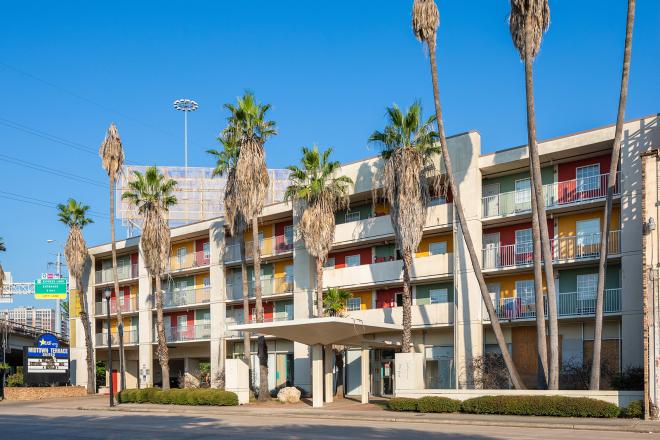
Animation of Air Quality Index (AQI), a combination of ozone and particulate matter, over 24-hour period. Source: airnow.gov.
The map of cancer risk associated with exposure to air toxins shown on the cover of Cite 93 and further discussed on this blog has been picked up by Swamplot, Houston Chronicle, KHOU, and CW39 NewsFix. The brief television reports focused on the east side of town, whereas our coverage stressed that health problems associated with air pollution affects affluent areas to the west as well. The post below is the first in a two-part series on the complexities of air pollution in Houston. Each post excerpts "Growing Risks" by Larry Soward, a former Commissioner at the Texas Commission on Environmental Quality. The full article is available in the print issue of Cite 93.
Population and economic growth in the Houston region create a virtuous cycle of business development, cultural vibrancy, and improved quality of life. There are also some significant costs and risks associated with that growth when it comes to our environment and our health. Let’s look at four growth areas that could significantly inhibit that virtuous cycle by compromising our air quality. The challenges are complex and require the region as a whole to face up to the hard choices ahead.
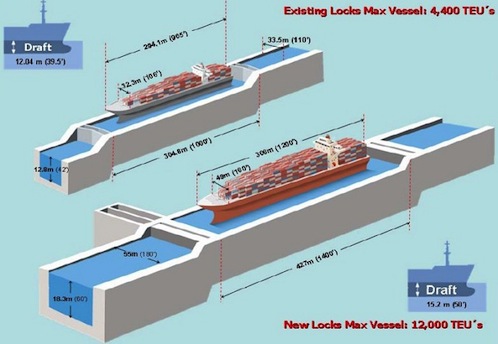
Panamax container ships dwarf today's giants. Source: maritime-connector.com.
1
PANAMAX
Unquestionably, one of the most significant growth events in the region involves the Port of Houston. The current expansion of the Panama Canal to accommodate larger vessels will double its capacity in 2014. With the increased container cargo trade resulting from this expansion, the Port of Houston finds itself well positioned for significant growth and will likely be one of the most positively impacted U.S. ports. The Port predicts that up to 40 percent growth in its shipping activity will come from the Canal’s creation of an efficient link between the Gulf of Mexico and the growing markets in East Asia, the west coast of South America, and the southern ports of Central America.
In addition to the Panama Canal expansion, shipping lines are also working with the Port to bring in the largest container vessels ever to call there, requiring significant infrastructure, both at the terminal and in the Ship Channel. To accommodate increased cargo volumes and larger ships, the Port has begun to construct additional or improved terminal facilities. The completion of a substantial portion of the Bayport Container Terminal at approximately the same time as the completion of the Panama Canal expansion is expected to triple the container-handling capacity of the Port. Furthermore, significant improvement or enlargement of the Ship Channel is also planned.
This extensive expansion of Port infrastructure and operations will necessarily have some significant impacts on the environs of the Ship Channel. As the Port expands, additional ship and barge traffic, and attendant support facilities, will raise air-pollutant emission and public health issues for citizens and communities in the area. Truck and rail load increases will not only impact the Port area, but likely a significant portion of the region. Truck volumes are expected to grow significantly along the major trade corridors serving the area’s port and waterway system. In 2007, a majority of all freight (61 percent, or more than 780 million tons) that moved across the region was hauled by truck. By 2035, the truck share is expected to grow to 65 percent, more than 1.2 billion tons yearly.
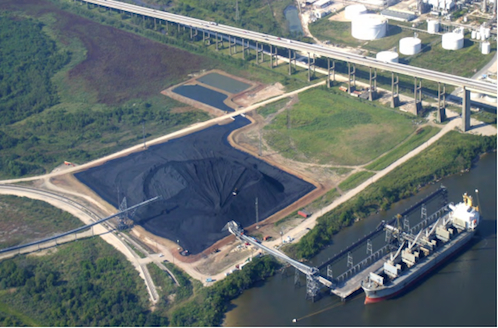
Kinder Morgan Deepwater Terminal. Source: kindermorgan.com.
2
COAL EXPORT TERMINALS
Related to the Port’s growth and even further impacting the environs of the Ship Channel are at least three other major development projects. The first involves growing efforts by Gulf Coast ports such as the Port of Houston to further capitalize on the Panama Canal expansion by capturing an exploding coal export market. Significant opposition to the construction and operation of a number of major coal export terminals proposed in the Pacific Northwest to export coal from mining areas in Wyoming and Montana to Asia has led coal producers to look to Gulf Coast ports for greater access. Given the huge economic opportunities presented by increased coal exports, these ports are actively seeking this export business. Where existing capacity is currently limited, the ports are planning necessary expansions to accommodate the projected new export volumes.
Plenty is already happening on the coal export front here in Houston. Kinder Morgan plans to expand its two terminals on the Ship Channel, where it now runs smaller docks for exporting petroleum coke generated by nearby refineries. As part of a $400 million expansion, these two terminals and one in Louisiana will begin exporting Colorado-mined coal in 2014, timed to the Panama Canal expansion completion. Marking the first export of western coal from the Port of Houston, the expanded terminals will handle three 135-car trains daily with an export capacity of over 10 million tons of coal annually. Likewise, down in Galveston, the Texas, Mexico & Pacific Railroad plans to build a railway bridge and tracks out to a new coal export terminal on Pelican Island, where as much as 15 million tons could be exported yearly.
Certainly, this increased coal exportation will bring positive economic impacts in terms of jobs and money. Yet significant environmental hazards and health impacts are also likely to result. By their very nature, coal export terminals are noisy, polluted with diesel fumes and coal dust, and dominated by huge, unsightly piles of coal, all often significantly impacting the environs. Since the cheapest way to get coal to port is by rail, rail traffic will radically increase, crowding out other rail-using commodities and necessarily prompting construction of new rail lines. Extremely long coal trains passing through the area will deposit polluting coal dust everywhere along the routes and bisect urban areas and roadways for hours every day. Finally, the introduction of new or expanded coal export terminals on the Ship Channel will further amplify the Port’s own expansion projects.
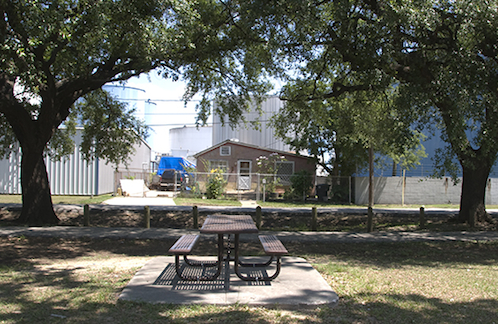
Manchester Park at Houston Ship Channel. Photo by Paul Hester.
3
KEYSTONE PIPELINE
Next, there is the Keystone Pipeline --- the $7 billion, 1,700-mile, 36-inch pipeline that, if approved, will carry over 700,000 barrels per day of tar sands crude from Alberta, Canada, across six states to the Gulf Coast. The southern portion of the pipeline, known as the Gulf Coast Project, will run 485 miles through 16 counties in north and east Texas from the Oklahoma border to refineries in Houston and Port Arthur, where coking facilities necessary to refine heavy crude are readily available. The 48-mile Houston Lateral Project will run through the counties of Liberty, Chambers, and Harris, transporting oil to refineries in the refinery/petrochemical complex along the Ship Channel.
Despite the positive economic benefits that the pipeline will bring, there are significant environmental concerns as to both the pipeline’s construction and operations, and the refining of the tar sands crude in area refineries. Processing the heavy, molasses-like tar sands oil into useable fuel will release more sulfur, nitrogen oxide, metals, and other toxic pollutants than conventional crude oil refining. Also, given the higher fuel input necessary to refine the tar sands into usable products, about 17 percent more greenhouse gas emissions are expected than with conventional refining. All said, it is only reasonable to expect air pollutant emissions to increase in the region; the only question is how much.
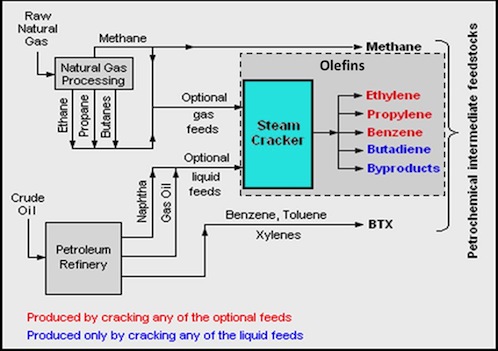
Diagram of ethylene processing. Source 2b1stconsulting.com/ethylene/.
4
PETROCHEMICAL PLANT EXPANSIONS
Finally, on the development front, our region is poised to see the largest petrochemical expansion in Texas since the days of cheap oil in the 1980s. Driven primarily by the natural gas boom, at least a dozen refineries and petrochemical plants in the region are moving forward with expansion projects to capitalize on the abundant supply of cheap natural gas, which is used as chemical feedstock. This has caused a rush of chemical industry investment and a sharp rise in demand for chemical industry employees, thus rejuvenating the petrochemical manufacturing sector and fostering significant exports.
These projects involve big names. ExxonMobil is building a new multibillion-dollar ethane cracker at its Baytown refinery and petrochemical complex. Scheduled to start up in 2016, the new facilities will process up to 1.5 million tons of chemicals annually and provide feedstock for a nearby polyethylene plant. As part of a $4 billion expansion plan also inspired by the shale gas boom, Dow Chemical Company is building a new $1.7 billion ethylene production plant at its huge chemical complex in Freeport. When completed in 2017, it will have an annual ethylene capacity of 3.3 billion pounds. Likewise, Chevron Phillips Chemical Company plans to spend $5 billion to build a new ethane cracker and 1-hexene plant at its Baytown petrochemical plant. And the list goes on!



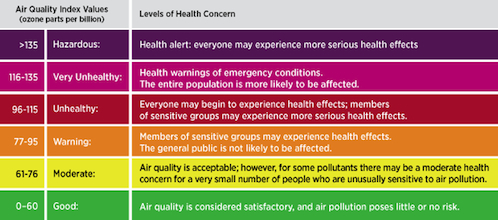
Unquestionably, all these major expansion projects will create thousands of new jobs and inject billions of dollars into the area economies. However, these enormous projects will also raise significant environmental and public health issues for areas already inundated with petrochemical plants and refineries and overburdened with environmental pollution and health risks. All these planned facilities might not be built, and certainly these newer plants will generally pollute less than plants built just a decade ago, yet those that are built will still add more air pollutants to the total pollution we already experience.
More >>>
Click here to read part 2.
Read more from Cite 93 about environmental issues.
Watch Larry Soward speak at the Rice Design Alliance Civic Forum on the Challenges of Competing Land Uses, Environmental Justice, and Public Health.









